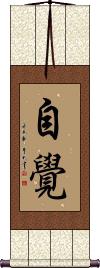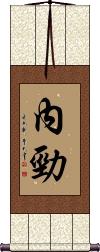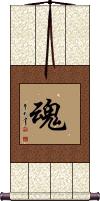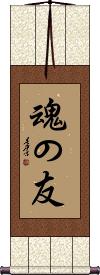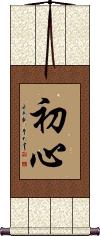Many custom options...
And formats...

Conscious in Chinese / Japanese...
Buy a Conscious calligraphy wall scroll here!
Personalize your custom “Conscious” project by clicking the button next to your favorite “Conscious” title below...
2. Neijing
6. Soul Mates
Consciousness of Self
自覺 is the idea of being conscious, self-aware, and sometimes “on one's own initiative.”
![]() After WWII, they started using a simplified form of the second Kanji for this word in Japan. That version is shown to the right, and you can click on that Kanji if you want the modern Japanese form. Otherwise, the characters shown in the upper left are the correct ones for ancient/old/traditional Chinese, Japanese, and Korean.
After WWII, they started using a simplified form of the second Kanji for this word in Japan. That version is shown to the right, and you can click on that Kanji if you want the modern Japanese form. Otherwise, the characters shown in the upper left are the correct ones for ancient/old/traditional Chinese, Japanese, and Korean.
Neijing
Self Consciousness
自意識 is the idea of being conscious and self-aware in Japanese Kanji and old Korean Hanja.
This is not a normal word in Chinese.
Soul / Spirit
魂 means soul or spirit as in the immortal soul that can be detached from the body.
This can also refer to one's Yang energy or spirit.
In the Buddhist context, this can be the soul, conscious mind, or vijñāna.
Spiritual Soul Mates
魂の伴侶 is a Japanese-only title for soulmates.
魂 means soul, spirit, immortal soul (the part of you that lives beyond your physical body), or the conscious mind. In the Buddhist context, this is vijñāna or viññāṇa (consciousness, life force, or mind).
の is a possessive article that connects everything here.
伴侶 means mates, companions, partners, and spouses.
Soul Mates
魂の友 is one of a few ways to write “Soul Mates” in Japanese.
The first Kanji means soul, spirit, ghost, immortal soul, the mind, or conscious mind. From Sanskrit, it's Vijñāna.
The middle character is a Japanese Hiragana connecting or possessive article that links the two ideas together.
The last Kanji means friends or friendship.
Mind of the Beginner
Shoshin
初心 is often translated in Japanese as “beginner's mind” or “beginner's spirit.”
In Chinese, the dictionary definition is “one's original intention.”
The first character means first, initial, primary, junior, beginning, or basic.
The second character means heart, mind, soul, or essence.
初心 is one of the five spirits of the warrior (budo) and is often used as a Japanese martial arts tenet. Under that context, places such as the Budo Dojo define it this way: The state of shoshin is that of a beginners mind. It is a state of awareness that always remains fully conscious, aware, and prepared to see things for the first time. The attitude of shoshin is essential to continued learning.
Not the results for conscious that you were looking for?
Below are some entries from our dictionary that may match your conscious search...
| Characters If shown, 2nd row is Simp. Chinese |
Pronunciation Romanization |
Simple Dictionary Definition |
佛 see styles |
fú fu2 fu hotoke ほとけ |
More info & calligraphy: Buddhism / Buddha(surname) Hotoke Buddha, from budh to "be aware of", "conceive", "observe", "wake"; also 佛陀; 浮圖; 浮陀; 浮頭; 浮塔; 勃陀; 勃馱; 沒馱; 母馱; 母陀; 部陀; 休屠. Buddha means "completely conscious, enlightened", and came to mean the enlightener. he Chinese translation is 覺 to perceive, aware, awake; and 智 gnosis, knowledge. There is an Eternal Buddha, see e.g. the Lotus Sutra, cap. 16, and multitudes of Buddhas, but the personality of a Supreme Buddha, an Ādi-Buddha, is not defined. Buddha is in and through all things, and some schools are definitely Pan-Buddhist in the pantheistic sense. In the triratna 三寳 commonly known as 三寳佛, while Śākyamuni Buddha is the first "person" of the Trinity, his Law the second, and the Order the third, all three by some are accounted as manifestations of the All-Buddha. As Śākyamuni, the title indicates him as the last of the line of Buddhas who have appeared in this world, Maitreya is to be the next. As such he is the one who has achieved enlightenment, having discovered the essential evil of existence (some say mundane existence, others all existence), and the way of deliverance from the constant round of reincarnations; this way is through the moral life into nirvana, by means of self-abnegation, the monastic life, and meditation. By this method a Buddha, or enlightened one, himself obtains Supreme Enlightenment, or Omniscience, and according to Māhāyanism leads all beings into the same enlightenment. He sees things not as they seem in their phenomenal but in their noumenal aspects, as they really are. The term is also applied to those who understand the chain of causality (twelve nidānas) and have attained enlightenment surpassing that of the arhat. Four types of the Buddha are referred to: (1) 三藏佛the Buddha of the Tripiṭaka who attained enlightenment on the bare ground under the bodhi-tree; (2) 通佛the Buddha on the deva robe under the bodhi-tree of the seven precious things; (3) 別佛the Buddha on the great precious Lotus throne under the Lotus realm bodhi-tree; and (4) 圓佛the Buddha on the throne of Space in the realm of eternal rest and glory where he is Vairocana. The Hīnayāna only admits the existence of one Buddha at a time; Mahāyāna claims the existence of many Buddhas at one and the same time, as many Buddhas as there are Buddha-universes, which are infinite in number. |
魂 see styles |
hún hun2 hun kokoro こころ |
More info & calligraphy: Soul / Spirit(See 魄) Yang energy; spirit; (female given name) Kokoro The mind, the soul, conscious mind, vijñāna; also 魂神. |
無我 无我 see styles |
wú wǒ wu2 wo3 wu wo muga むが |
More info & calligraphy: Selflessness(1) selflessness; self-effacement; self-renunciation; (2) {Buddh} anatta; anatman; doctrine that states that humans do not possess souls; (female given name) Muga anātman; nairātmya; no ego, no soul (of an independent and self-contained character), impersonal, no individual independent existence (of conscious or unconscious beings, anātmaka). The empirical ego is merely an aggregation of various elements, and with their disintegration it ceases to exist; therefore it has nm ultimate reality of its own, but the Nirvāṇa Sūtra asserts the reality of the ego in the transcendental realm. The non-Buddhist definition of ego is that it has permanent individuality 常一之體 and is independent or sovereign 有主宰之用. When applied to men it is 人我, when to things it is 法我. Cf. 常 11. |
自覺 自觉 see styles |
zì jué zi4 jue2 tzu chüeh jigaku じがく |
More info & calligraphy: Consciousness of Self(surname) Jigaku to realize for oneself |
菩薩 菩萨 see styles |
pú sà pu2 sa4 p`u sa pu sa mizoro みぞろ |
More info & calligraphy: Bodhisattva(n,n-suf) (1) {Buddh} bodhisattva; one who has reached enlightenment but vows to save all beings before becoming a buddha; (n,n-suf) (2) High Monk (title bestowed by the imperial court); (n,n-suf) (3) (See 本地垂迹説) title bestowed to Shinto kami in manifestation theory; (surname) Mizoro bodhisattva, cf. 菩提薩埵. While the idea is not foreign to Hīnayāna, its extension of meaning is one of the chief marks of Mahāyāna. 'The Bodhisattva is indeed the characteristic feature of the Mahāyāna.' Keith. According to Mahāyāna the Hinayanists, i.e. the śrāvaka and pratyekabuddha, seek their own salvation, while the bodhisattva's aim is the salvation of others and of all. The earlier intp. of bodhisattva was 大道心衆生 all beings with mind for the truth; later it became 大覺有情 conscious beings of or for the great intelligence, or enlightenment. It is also intp. in terms of leadership, heroism, etc. In general it is a Mahayanist seeking Buddhahood, but seeking it altruistically; whether monk or layman, he seeks enlightenment to enlighten others, and he will sacrifice himself to save others; he is devoid of egoism and devoted to helping others. All conscious beings having the Buddha-nature are natural bodhisattvas, but require to undergo development. The mahāsattva is sufficiently advanced to become a Buddha and enter nirvāṇa, but according to his vow he remains in the realm of incarnation to save all conscious beings. A monk should enter on the arduous course of discipline which leads to Bodhisattvahood and Buddhahood. |
達磨 达磨 see styles |
dá mó da2 mo2 ta mo daruma だるま |
More info & calligraphy: Daruma / Damodharma; also 達摩; 達麼; 達而麻耶; 曇摩; 馱摩 tr. by 法. dharma is from dhara, holding, bearing, possessing, etc.; and means 'that which is to be held fast or kept, ordinance, statute, law, usage, practice'; 'anything right.' M.W. It may be variously intp. as (1) characteristic, attribute, predicate; (2) the bearer, the transcendent substratum of single elements of conscious life; (3) element, i.e. a part of conscious life; (4) nirvāṇa, i.e. the Dharma par excellence, the object of Buddhist teaching; (5) the absolute, the real; (6) the teaching or religion of Buddha; (7) thing, object, appearance. Also, Damo, or Bodhidharma, the twenty-eighth Indian and first Chinese patriarch, who arrived in China A.D. 520, the reputed founder of the Chan or Intuitional School in China. He is described as son of a king in southern India; originally called Bodhitara. He arrived at Guangdong, bringing it is said the sacred begging-bowl, and settled in Luoyang, where he engaged in silent meditation for nine years, whence he received the title of wall-gazing Brahman 壁觀婆羅門, though he was a kṣatriya. His doctrine and practice were those of the 'inner light', independent of the written word, but to 慧可 Huike, his successor, he commended the Laṅkāvatāra-sūtra as nearest to his views. There are many names with Dharma as initial: Dharmapāla, Dharmagupta, Dharmayaśas, Dharmaruci, Dharmarakṣa, Dharmatrāta, Dharmavardhana, etc. |
五智 see styles |
wǔ zhì wu3 zhi4 wu chih gochi ごち |
(place-name, surname) Gochi The five kinds of wisdom of the 眞言宗 Shingon School. Of the six elements 六大 earth, water, fire, air (or wind), ether (or space) 曇空, and consciousness (or mind 識 ), the first five form the phenomenal world, or Garbhadhātu, the womb of all things 胎藏界, the sixth is the conscious, or perceptive, or wisdom world, the Vajradhātu 金剛界, sometimes called the Diamond realm. The two realms are not originally apart, but one, and there is no consciousness without the other five elements. The sixth element, vijñāna, is further subdivided into five called the 五智 Five Wisdoms: (1) 法界體性智 dharmadhātu-prakṛti-jñāna, derived from the amala-vijñāna, or pure 識; it is the wisdom of the embodied nature of the dharmadhātu, defined as the six elements, and is associated with Vairocana 大日, in the centre, who abides in this samādhi; it also corresponds to the ether 空 element. (2) 大圓鏡智 adarśana-jñāna, the great round mirror wisdom, derived from the ālaya-vijñāna, reflecting all things; corresponds to earth, and is associated with Akṣobhya and the east. (3) 平等性智 samatā-jñāna, derived from mano-vijñāna, wisdom in regard to all things equally and universally; corresponds to fire, and is associated with Ratnasaṃbhava and the south. (4) 妙觀察智 pratyavekṣaṇa-jñāna, derived from 意識, wisdom of profound insight, or discrimination, for exposition and doubt-destruction; corresponds to water, and is associated with Amitābha and the west. (5) 成所作智 kṛtyānuṣṭhāna-jñāna, derived from the five senses, the wisdom of perfecting the double work of self-welfare and the welfare of others; corresponds to air 風 and is associated with Amoghasiddhi and the north. These five Dhyāni-Buddhas are the 五智如來. The five kinds of wisdom are the four belonging to every Buddha, of the exoteric cult, to which the esoteric cult adds the first, pure, all-refecting, universal, all-discerning, and all-perfecting. |
性命 see styles |
xìng mìng xing4 ming4 hsing ming shōmyō |
life The life of conscious beings; nature and life. |
情有 see styles |
qíng yǒu qing2 you3 ch`ing yu ching yu jōu |
The realm of feeling, i.e. any world of sentience or feeling, especially this world as empirically considered; 有情 is to have consciousness, the conscious, or sentient. |
惺忪 see styles |
xīng sōng xing1 song1 hsing sung |
drowsy-eyed; (literary) wavering; indecisive; (literary) awake; conscious; clearheaded |
懷靈 怀灵 see styles |
huái líng huai2 ling2 huai ling eryō |
Spirit-enfolders, i.e. all conscious beings. |
殺生 杀生 see styles |
shā shēng sha1 sheng1 sha sheng setsuna せつな |
to take the life of a living creature (n,vs,vt,vi) (1) killing; destruction of life; (adjectival noun) (2) cruel; heartless; callous; brutal; (female given name) Setsuna To take life, kill the living, or any conscious being; the taking of human life offends against the major commands, of animal life against the less stringent commands. Suicide also leads to severe penalties. |
知る see styles |
shiru しる |
(transitive verb) (1) to be aware of; to know; to be conscious of; to cognize; to cognise; (2) to notice; to feel; (3) to understand; to comprehend; to grasp; (4) to remember; to be acquainted with (a procedure); (5) to experience; to go through; to learn; (6) to be acquainted with (a person); to get to know; (7) to concern |
羣生 群生 see styles |
qún shēng qun2 sheng1 ch`ün sheng chün sheng gunshō |
All the living, especially all living, conscious beings. |
自罪 see styles |
zì zuì zi4 zui4 tzu tsui ji zai |
actual sin (Christian notion, as opposed to original sin 原罪); conscious sin one's own crime(s) |
衆生 众生 see styles |
zhòng shēng zhong4 sheng1 chung sheng shujou; shuusei; sujou(ok) / shujo; shuse; sujo(ok) しゅじょう; しゅうせい; すじょう(ok) |
{Buddh} all living things; mankind; the people; the world sattva; all the living, living beings, older tr. 有情 sentient, or conscious beings; also many lives, i.e. many transmigrations. |
識る see styles |
shiru しる |
(transitive verb) (1) to be aware of; to know; to be conscious of; to cognize; to cognise; (2) to notice; to feel; (3) to understand; to comprehend; to grasp; (4) to remember; to be acquainted with (a procedure); (5) to experience; to go through; to learn; (6) to be acquainted with (a person); to get to know; (7) to concern |
識物 识物 see styles |
shì wù shi4 wu4 shih wu shikimotsu |
conscious beings |
識省 识省 see styles |
shì shěng shi4 sheng3 shih sheng shikishō |
to be conscious of |
迷糊 see styles |
mí hu mi2 hu5 mi hu |
muddle-headed; dazed; only half conscious |
隨意 随意 see styles |
suí yì sui2 yi4 sui i zui'i |
as one wishes; according to one's wishes; at will; voluntary; conscious At will, following one's own wishes. |
お洒落 see styles |
oshare おしゃれ |
(adj-na,adj-no) (1) (kana only) smartly dressed; stylish; fashion-conscious; (2) (kana only) someone smartly dressed; (noun or participle which takes the aux. verb suru) (3) (kana only) to dress up; to be fashionable |
シャレ see styles |
jare ジャレ |
(noun or adjectival noun) (1) joke; pun; witticism; (adjectival noun) (2) smartly dressed; stylish; fashion-conscious; refined; (personal name) Jallais |
びびる see styles |
bibiru ビビる |
(v5r,vi) (1) to feel nervous; to feel afraid; to feel self-conscious; to lose one's nerve; to get cold feet; to get the jitters; (2) (colloquialism) to be startled; to be surprised; to be shocked; to feel frightened; to be spooked; (3) (archaism) to be shy; to be bashful; (surname) Bibiru |
中二病 see styles |
zhōng èr bìng zhong1 er4 bing4 chung erh ping chuunibyou / chunibyo ちゅうにびょう |
(neologism) strange behavior characteristic of a teenager going through puberty (loanword from Japanese "chūnibyō") (slang) (joc) behaving in a way characteristic of teenagers going through puberty, esp. by being overly self-conscious; 2nd year of junior high sickness |
二世間 二世间 see styles |
èr shì jiān er4 shi4 jian1 erh shih chien ni seken |
The two realms of conscious or sentient beings 有情世間, and unconscious or material things 器世間. |
厨二病 see styles |
chuunibyou / chunibyo ちゅうにびょう |
(slang) (joc) behaving in a way characteristic of teenagers going through puberty, esp. by being overly self-conscious; 2nd year of junior high sickness |
御洒落 see styles |
oshare おしゃれ |
(adj-na,adj-no) (1) (kana only) smartly dressed; stylish; fashion-conscious; (2) (kana only) someone smartly dressed; (noun or participle which takes the aux. verb suru) (3) (kana only) to dress up; to be fashionable |
意識化 see styles |
ishikika いしきか |
(noun/participle) (1) becoming aware (of); becoming conscious (of); realization; (noun/participle) (2) {phil} conscientization; (formation of) critical consciousness |
意識的 see styles |
ishikiteki いしきてき |
(adjectival noun) conscious; deliberate; intentional |
Click here for more conscious results from our dictionary
The following table may be helpful for those studying Chinese or Japanese...
| Title | Characters | Romaji (Romanized Japanese) | Various forms of Romanized Chinese | |
| Consciousness of Self | 自覺 自觉 / 自覚 | jikaku | zì jué / zi4 jue2 / zi jue / zijue | tzu chüeh / tzuchüeh |
| Neijing | 內勁 内劲 | nèi jìng / nei4 jing4 / nei jing / neijing | nei ching / neiching | |
| Self Consciousness | 自意識 自意识 | jiishiki / jishiki | ||
| Soul Spirit | 魂 | tamashi / kon | hún / hun2 / hun | |
| Spiritual Soul Mates | 魂の伴侶 | tamashii no han ryo tamashiinohanryo tamashi no han ryo | ||
| Soul Mates | 魂の友 | tamashii no tomo tamashiinotomo tamashi no tomo | ||
| Mind of the Beginner | 初心 | sho shin / shoshin | chū xīn / chu1 xin1 / chu xin / chuxin | ch`u hsin / chuhsin / chu hsin |
| In some entries above you will see that characters have different versions above and below a line. In these cases, the characters above the line are Traditional Chinese, while the ones below are Simplified Chinese. | ||||
Successful Chinese Character and Japanese Kanji calligraphy searches within the last few hours...
